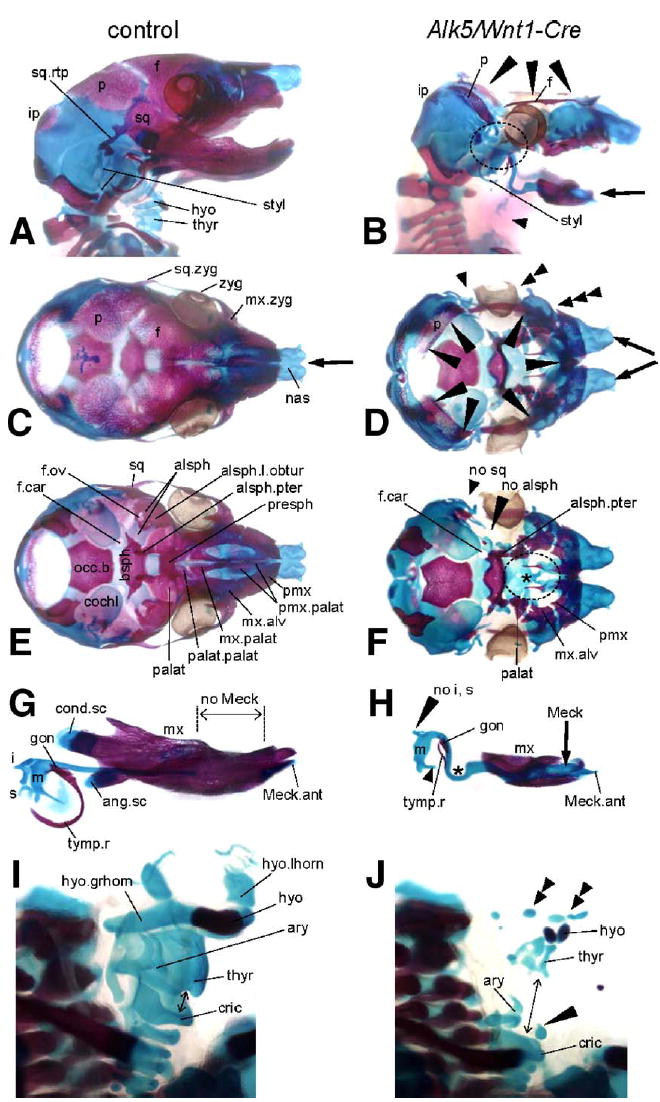Fig. 5.

Bone and cartilage defects resulting from deletion of Alk5 in neural crest cells. Bone (red) and cartilage (blue) staining in E18 embryos; controls are on the left side, mutants on the right. Stereoscopic magnification ×5; magnification ×7 used for panels G and H, ×15 for panels I and J. (A–B) Lateral views demonstrate a large defect in calvaria, which is almost completely missing in Alk5/Wnt1-Cre mutants. Only small portions of the parietal and frontal bones remain and form a thin ring around the cranial base (long arrowheads). Shortened mandible (arrow) and multiple anomalies in the region of the absent temporomandibular joint (circled) are other prominent skeletal features of Alk5/Wnt1-Cre embryos, together with almost completely missing laryngeal cartilages and hyoid bone (short arrowhead). (C–D) Superior view shows a lack of all three components of the zygomatic arch (arrowheads), cleft in the region of nasal cartilages underlying the cleft snout (arrows), and missing calvaria as mentioned above (long arrowheads). (E–F) Inferior view after removal of the mandible with middle ear ossicles reveals a large defect in the bony palate (circled) due to rudimentary palatine, maxillary, and premaxillary palatal components. Arrowheads point to locations of missing squamosal and alisphenoid bones; asterisk marks missing presphenoid ossification. (G–H) Lateral view of the mandibular complexes with Meckel's cartilage and middle ear ossicles. Mutants show remarkable differences when compared to control littermates in the persistence and curvature of Meckel's cartilage (asterisk), defects in formation of the secondary cartilages, and impaired middle ear bones (missing incus and stapes, incomplete tympanic ring). (I–J) Semilateral view of the laryngeal region. In mutants, rudiments of the hyoid bone and thyroid cartilage appear as multiple small elements scattered in an anatomically correct location (double arrowheads). The cricoarytenoid complex is positioned abnormally low, at the level of the upper thoracic aperture, resulting in a gap in the laryngeal skeleton (arrow). The long arrowhead points to a midline cartilage of unknown origin. alsph—alisphenoid bone; alsph.l.obtur—lamina obturans; alsph.pter—pterygoid process of alisphenoid bone; ang.sc—secondary cartilage of the angular process; ary—arytenoid cartilage; bsph—basisphenoid bone; cochl—cochlear part of the temporal bone; cond.sc—secondary cartilage of the condylar process; cric—cricoid cartilage; f—frontal bone; hyo—hyoid bone; hyo.grhorn—greater horn of the hyoid bone; hyo.lhorn—lesser horn of the hyoid bone; i—incus; ip—intraparietal bone; f.car—foramen caroticum; f.ov—foramen ovale; gon—gonium; m—malleus; Meck.ant—anterior process of Meckel's cartilage; mx—maxilla; mx.alv—alveolar process of maxilla; mx.palat—palatal process of maxilla; mx.zyg—zygomatic process of maxilla; nas —nasal cartilages; no—used for missing structures; occ.b—basis of the occipital bone; p—parietal bone; palat—palatal bone; palat.palat—palatal process of palatal bone; pmx—premaxilla; pmx.palat—palatal process of premaxilla; s—stapes; sq—squamous bone; sq.rtp—retrotympanic process of the squamal bone; styl—styloid process; thyr—thyroid cartilage; tymp.r—tympanic ring; zyg—zygomatic (jugal) bone.
